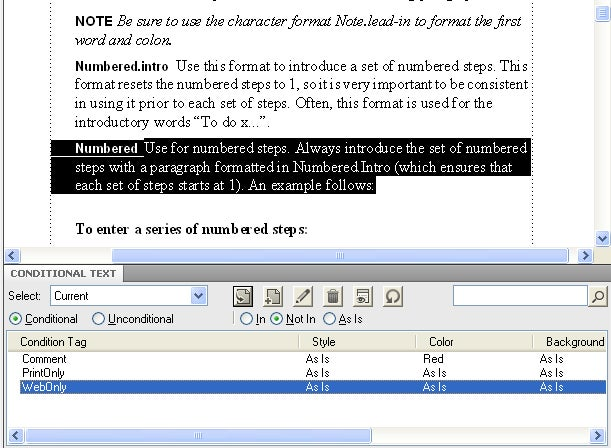Troubleshooting FrameMaker Content Conversion in RoboHelp – Part 3: Conditions
As I received feedback from several users, they found the first two blog posts of the series helpful. In this third blog post of the series, I am going to discuss about Conditions or Conditional Build Tags (“CBT”) and how to manage them in Technical Communication Suite 3.5.
How do I manage my conditons in RoboHelp which were defined in FrameMaker?
Many times, users wonder, if they can show or hide conditions while publishing in RoboHelp although they were defined and applied in FrameMaker. The answer to this query is Yes, you can.
RoboHelp is friendly enough to talk to FrameMaker and understand its conditions inside a FrameMaker document. Here is how you can do that.
Although, you must be well versed with conditions in FrameMaker, here is a quick recap to understand how one can apply them in FrameMaker.
- Select any content in FrameMaker where Condition is to be applied
- Click Special > Conditional Text > Conditional Text
- Conditional Text pod is opened. You can select a condition to apply it. Or you can create a new condition using the pod and apply it.
-

Once the document having these conditions defined is Updated/Imported in RoboHelp, these conditions are automatically imported in RoboHelp (if it is not turned off explicitly which is discussed in the later part of the blog).

Thus RoboHelp understands FrameMaker conditions and imports them. Once imported, they are visible as RoboHelp Conditional Build Tags along with other existing Conditional Build Tags in RoboHelp. One can open this Conditional Build Tags pod from View > Pods > Conditional Build Tags menu item.
Once these conditions are imported, they can be turned on/off in RoboHelp while publishing. For example, while generating WebHelp one can create Conditional Build Expressions to include/exclude them in the SSL dialog

In this way, conditions defined and applied in FrameMaker can be managed in RoboHelp while publishing.
I am a FrameMaker guy. Can I do it from FrameMaker?
Some user may argue that I am well versed with managing conditions in FrameMaker. I use RoboHelp for publishing. Do I need to learn managing conditions in RoboHelp if I do not want to? The answer is No. You can do it the way you want.
RoboHelp is again respectful to FrameMaker to honour the conditional expressions defined in FrameMaker when instructed to do so.
In order to achieve that one need to do the following
- Define and apply the conditions in FrameMaker as described above.
- Show/Hide conditions in FrameMaker using Show/Hide Conditional Text Pod in FrameMaker:
-

- In RoboHelp, turn on the check box for “Apply FrameMaker Conditional Text Build Expression”.
-

- This setting is present in Other Settings in Conversion Settings dialog. The dialog can be launced as follows:
- Go to File > Project Settings
- Go to Import tab
- Click Edit button for Conversion settings for FrameMaker to launch Conversion Settings dialog
- Update/Import FrameMaker document in RoboHelp
Once this is done, RoboHelp will apply the Conditional Expression defined in FrameMaker on the FrameMaker content and will import the filtered content. In this case, FrameMaker conditions will not be imported in RoboHelp as they are already resolved in FrameMaker. So, you need not manage those conditions in RoboHelp.
This way Technical Communication Suite 3.5 provides a user friendly way to manage conditions or conditional build tags either in RoboHelp or FrameMaker as per the user’s expertise and does not force the users to use a particular way.
I hope this blog is helpful and throws enough light in the area of managing conditions in Technical Communication Suite 3.5.
Mayank Agrawal, RoboHelp Engineering
This blog post is part of a 3-part Series: